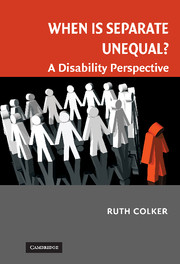Book contents
- Frontmatter
- Contents
- Preface
- Acknowledgments
- 1 Introduction
- 2 Anti-Subordination Above All: A Disability Perspective
- 3 The Mythic 43 Million Americans with Disabilities at the Workplace
- 4 K–12 Education
- 5 Higher Education and Testing Accommodations
- 6 Voting
- 7 Reflections on Race: The Limits of Formal Equality
- Index
3 - The Mythic 43 Million Americans with Disabilities at the Workplace
Published online by Cambridge University Press: 05 June 2012
- Frontmatter
- Contents
- Preface
- Acknowledgments
- 1 Introduction
- 2 Anti-Subordination Above All: A Disability Perspective
- 3 The Mythic 43 Million Americans with Disabilities at the Workplace
- 4 K–12 Education
- 5 Higher Education and Testing Accommodations
- 6 Voting
- 7 Reflections on Race: The Limits of Formal Equality
- Index
Summary
One of the primary challenges of an anti-subordination perspective is defining who is in the covered class. How would we define the group in society that has faced a history of subordination and deserves legally mandated remedies? The answer to that question will depend, in part, on the area of the law in which we seek to legislate. The purpose of legislation should be to remedy the conditions of subordination within a particular context.
This chapter will focus on one group that has been the target of Congress's assistance – those who are disabled and need protection from discrimination at the workplace. In 1990, Congress sought to provide legal remedies for those individuals under Title I of the Americans with Disabilities Act (ADA). It defined disability as constituting “a physical or mental impairment that substantially limits one or more major life activity.” Further, Congress stated that it would protect those who are disabled under that definition, have a record of disability (but are no longer disabled), or are falsely regarded as having a disability. Finally, Congress stated that it intended to cover “some 43,000,000 Americans” and recognized that “this number is increasing as the population as a whole is growing older.”
Although one could criticize Congress's definition of disability under the ADA, and its intention to provide protection against workplace discrimination to only 43 million Americans, this chapter will assume that Congress made a reasonable policy judgment to protect a subset of workers with disabilities.
- Type
- Chapter
- Information
- When is Separate Unequal?A Disability Perspective, pp. 39 - 77Publisher: Cambridge University PressPrint publication year: 2008



